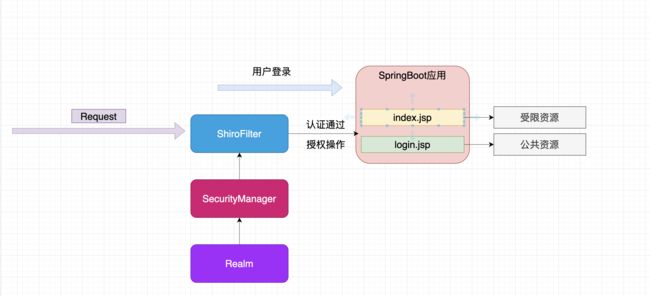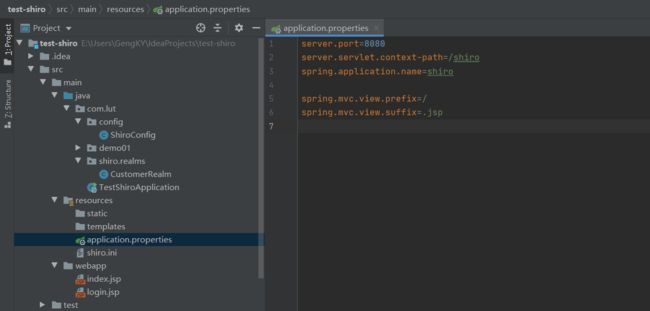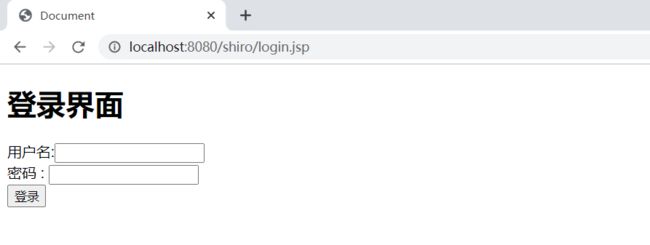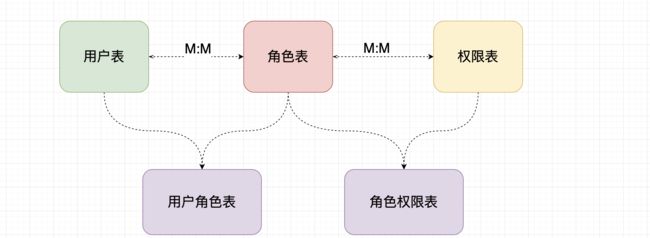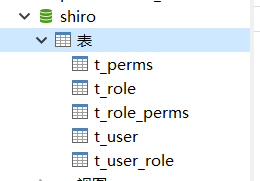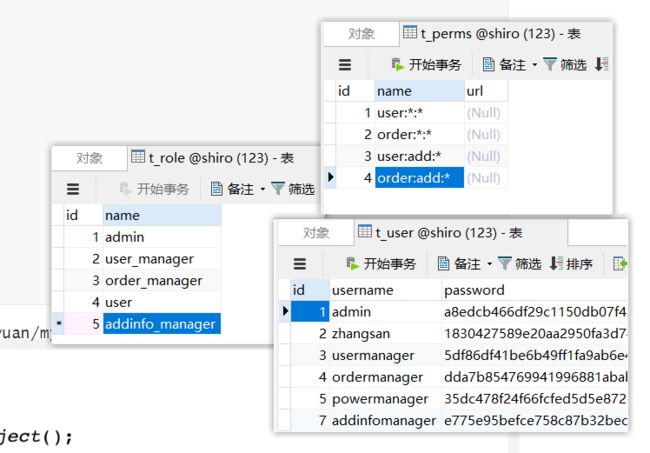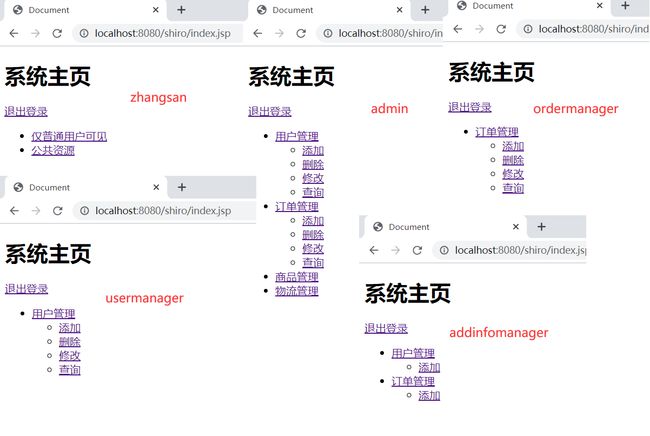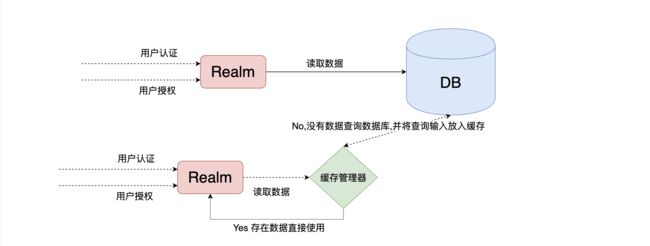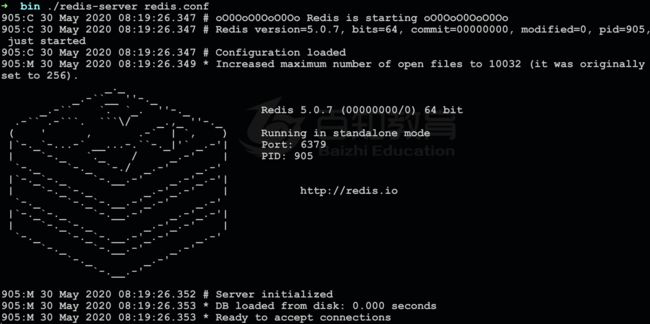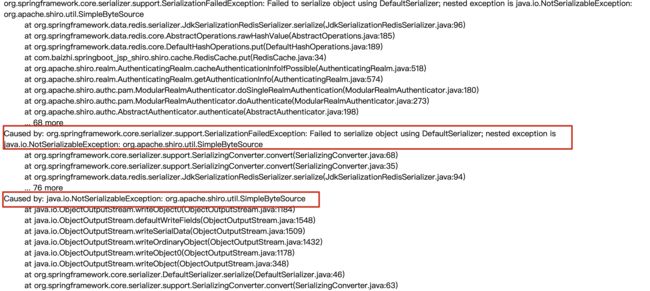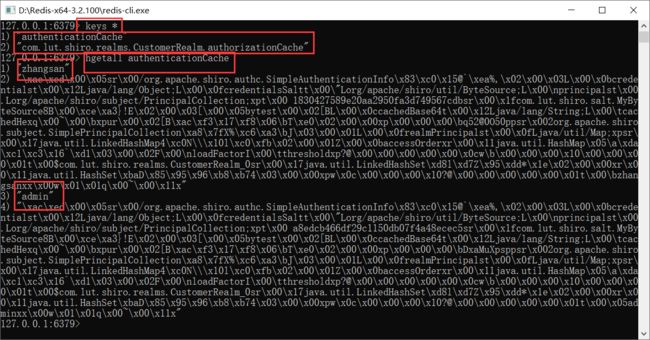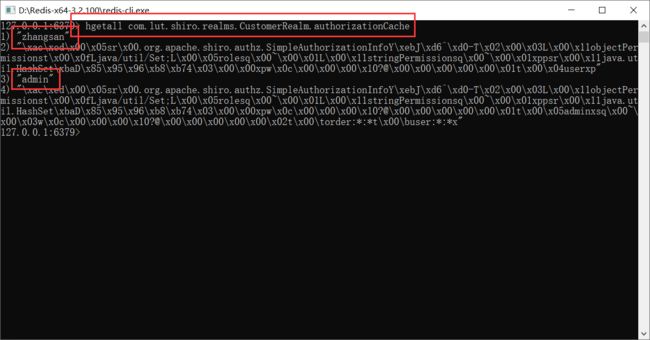Shiro学习笔记_03:整合SpringBoot项目实战
Shiro 学习笔记
本文基于B站UP主【编程不良人】视频教程【2020最新版Shiro教程,整合SpringBoot项目实战教程】进行整理记录,仅用于个人学习交流使用。
视频链接:https://www.bilibili.com/video/BV1uz4y197Zm
官方文档:http://www.baizhiedu.xin
目录标题
- Shiro 学习笔记
-
- 六、整合SpringBoot项目实战
-
- 6.1 整合思路
- 6.2 配置环境
- 6.3 简单使用
- 6.4 常见过滤器
- 6.5 认证和退出实现
-
- 6.5.1 登录实现
- 6.5.2 退出认证
- 6.7 MD5、Salt的认证实现
-
- 6.7.1 用户注册+随机盐处理
-
- 1.导入依赖
- 2.application.properties
- 3.创建数据库
- 4.创建entity
- 5.创建DAO接口
- 6.开发mapper配置文件
- 7.开发service接口
- 8.创建salt工具类
- 9.开发service实现类
- 10.开发Controller
- 11.设置公共资源
- 12.测试
- 6.7.2 开发数据库认证
-
- 1.开发DAO
- 2.开发mapper配置文件
- 3.开发Service接口
- 4.开发Service实现类
- 5.开发工厂工具类
- 6.修改自定义realm
- 7.修改ShiroConfig中realm
- 8.启动测试
- 6.8 授权实现
-
- 6.8.1 没有数据库
-
- 1.页面资源授权
- 2.代码方式授权
- 3.方法调用授权
- 6.8.2 连接数据库
-
- 4.授权数据持久化
- 5.创建实体类
- 6.创建dao方法
- 7.mapper实现
- 8.Service接口
- 9.Service实现
- 10.修改自定义realm
- 11.向数据库添加信息
- 12.启动测试
- 6.9 使用CacheManager
-
- 6.9.1 Cache 作用
- 6.9.2 使用shiro中默认EhCache实现缓存
-
- 1.引入依赖
- 2.开启缓存
- 3.启动刷新页面进行测试
- 6.9.3 shiro中使用Redis作为缓存实现
-
- 1.引入redis依赖
- 2.配置redis连接
- 3.启动redis服务
- 4.开发RedisCacheManager
- 5.开RedisCache实现
- 6.启动项目测试发现报错
- 7.再次启动测试,发现可以成功放入redis缓存
- 6.9.4 加入验证码验证
-
- 1.验证码工具类
- 2.开发页面加入验证码
- 3.开发控制器
- 4.放行验证码
- 5.修改认证流程
- 6.修改salt不能序列化的问题
- 7.启动测试
- 6.9.5 JSP中Shiro常用标签
六、整合SpringBoot项目实战
6.1 整合思路
6.2 配置环境
1.创建项目
2.引入依赖
<dependency>
<groupId>org.apache.tomcat.embedgroupId>
<artifactId>tomcat-embed-jasperartifactId>
dependency>
<dependency>
<groupId>jstlgroupId>
<artifactId>jstlartifactId>
<version>1.2version>
dependency>
<dependency>
<groupId>org.apache.shirogroupId>
<artifactId>shiro-spring-boot-starterartifactId>
<version>1.5.3version>
dependency>
3.修改视图
application.properties 文件
server.port=8080
server.servlet.context-path=/shiro
spring.application.name=shiro
spring.mvc.view.prefix=/
spring.mvc.view.suffix=.jsp
4.修改配置
JSP 与IDEA 与SpringBoot存在一定的不兼容,修改此配置即可解决
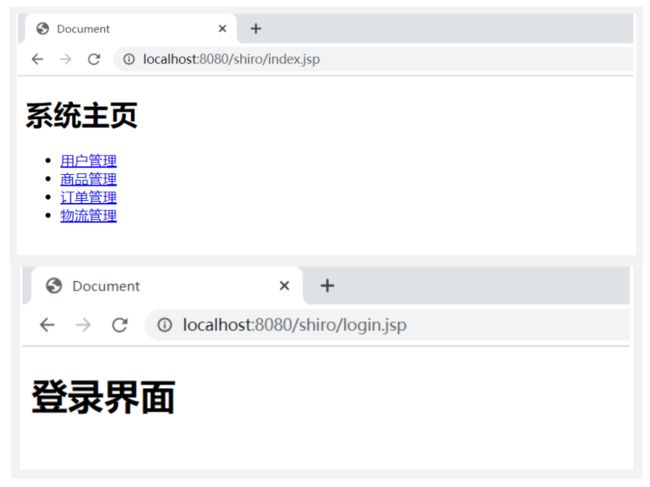
6.3 简单使用
1.创建配置类
用来整合shiro框架相关的配置类
package com.lut.config;
import com.lut.shiro.realms.CustomerRealm;
import org.apache.shiro.authc.credential.HashedCredentialsMatcher;
import org.apache.shiro.realm.Realm;
import org.apache.shiro.spring.web.ShiroFilterFactoryBean;
import org.apache.shiro.web.mgt.DefaultWebSecurityManager;
import org.springframework.context.annotation.Bean;
import org.springframework.context.annotation.Configuration;
import java.util.HashMap;
import java.util.Map;
/**
* 用来整合shiro框架相关的配置类
*/
@Configuration
public class ShiroConfig {
//1.创建shiroFilter //负责拦截所有请求
@Bean
public ShiroFilterFactoryBean getShiroFilterFactoryBean(DefaultWebSecurityManager defaultWebSecurityManager){
ShiroFilterFactoryBean shiroFilterFactoryBean = new ShiroFilterFactoryBean();
//给filter设置安全管理器
shiroFilterFactoryBean.setSecurityManager(defaultWebSecurityManager);
//配置系统受限资源
//配置系统公共资源
Map<String,String> map = new HashMap<String,String>();
map.put("/index.jsp","authc");//authc 请求这个资源需要认证和授权
//默认认证界面路径---当认证不通过时跳转
shiroFilterFactoryBean.setLoginUrl("/login.jsp");
shiroFilterFactoryBean.setFilterChainDefinitionMap(map);
return shiroFilterFactoryBean;
}
//2.创建安全管理器
@Bean
public DefaultWebSecurityManager getDefaultWebSecurityManager(Realm realm){
DefaultWebSecurityManager defaultWebSecurityManager = new DefaultWebSecurityManager();
//给安全管理器设置
defaultWebSecurityManager.setRealm(realm);
return defaultWebSecurityManager;
}
//3.创建自定义realm
@Bean
public Realm getRealm(){
CustomerRealm customerRealm = new CustomerRealm();
return customerRealm;
}
}
2.自定义realm
package com.lut.shiro.realms;
import org.apache.shiro.authc.AuthenticationException;
import org.apache.shiro.authc.AuthenticationInfo;
import org.apache.shiro.authc.AuthenticationToken;
import org.apache.shiro.authc.SimpleAuthenticationInfo;
import org.apache.shiro.authz.AuthorizationInfo;
import org.apache.shiro.authz.SimpleAuthorizationInfo;
import org.apache.shiro.realm.AuthorizingRealm;
import org.apache.shiro.subject.PrincipalCollection;
import org.springframework.util.CollectionUtils;
import org.springframework.util.ObjectUtils;
import java.util.List;
//自定义realm
public class CustomerRealm extends AuthorizingRealm {
@Override
protected AuthorizationInfo doGetAuthorizationInfo(PrincipalCollection principals) {
return null;
}
@Override
protected AuthenticationInfo doGetAuthenticationInfo(AuthenticationToken token) throws AuthenticationException {
return null;
}
}
3.JSP文件
index.jsp
<%@page contentType="text/html;utf-8" pageEncoding="utf-8" isELIgnored="false" %>
Document
<%-- 受限资源--%>
系统主页
login.jsp
<%@page contentType="text/html;utf-8" pageEncoding="utf-8" isELIgnored="false" %>
Document
登录界面
4.简单测试
访问:http://localhost:8080/shiro/index.jsp
由于没有验证成功,会跳转到登录页面
目前项目结构:
6.4 常见过滤器
- 注意: shiro提供和多个默认的过滤器,我们可以用这些过滤器来配置控制指定url的权限:
| 配置缩写 | 对应的过滤器 | 功能 |
|---|---|---|
| anon | AnonymousFilter | 指定url可以匿名访问(访问时不需要认证授权) |
| authc | FormAuthenticationFilter | 指定url需要form表单登录,默认会从请求中获取username、password,rememberMe等参数并尝试登录,如果登录不了就会跳转到loginUrl配置的路径。我们也可以用这个过滤器做默认的登录逻辑,但是一般都是我们自己在控制器写登录逻辑的,自己写的话出错返回的信息都可以定制嘛。 |
| authcBasic | BasicHttpAuthenticationFilter | 指定url需要basic登录 |
| logout | LogoutFilter | 登出过滤器,配置指定url就可以实现退出功能,非常方便 |
| noSessionCreation | NoSessionCreationFilter | 禁止创建会话 |
| perms | PermissionsAuthorizationFilter | 需要指定权限才能访问 |
| port | PortFilter | 需要指定端口才能访问 |
| rest | HttpMethodPermissionFilter | 将http请求方法转化成相应的动词来构造一个权限字符串,这个感觉意义不大,有兴趣自己看源码的注释 |
| roles | RolesAuthorizationFilter | 需要指定角色才能访问 |
| ssl | SslFilter | 需要https请求才能访问 |
| user | UserFilter | 需要已登录或“记住我”的用户才能访问 |
6.5 认证和退出实现
6.5.1 登录实现
1.login.jsp
<%@page contentType="text/html;utf-8" pageEncoding="utf-8" isELIgnored="false" %>
Document
登录界面
2.UserController
package com.lut.controller;
import org.apache.shiro.SecurityUtils;
import org.apache.shiro.authc.IncorrectCredentialsException;
import org.apache.shiro.authc.UnknownAccountException;
import org.apache.shiro.authc.UsernamePasswordToken;
import org.apache.shiro.subject.Subject;
import org.springframework.beans.factory.annotation.Autowired;
import org.springframework.stereotype.Controller;
import org.springframework.web.bind.annotation.RequestMapping;
import javax.servlet.ServletOutputStream;
import javax.servlet.http.HttpServletResponse;
import javax.servlet.http.HttpSession;
import java.io.IOException;
@Controller
@RequestMapping("user")
public class UserController {
/**
* 用来处理身份认证
* @param username
* @param password
* @return
*/
@RequestMapping("login")
public String login(String username, String password) {
try {
//获取主体对象
Subject subject = SecurityUtils.getSubject();
subject.login(new UsernamePasswordToken(username, password));
return "redirect:/index.jsp";
} catch (UnknownAccountException e) {
e.printStackTrace();
System.out.println("用户名错误!");
} catch (IncorrectCredentialsException e) {
e.printStackTrace();
System.out.println("密码错误!");
} catch (Exception e) {
e.printStackTrace();
System.out.println(e.getMessage());
}
return "redirect:/login.jsp";
}
}
- 在认证过程中使用subject.login进行认证
3.自定义Realm
package com.lut.shiro.realms;
import org.apache.shiro.authc.AuthenticationException;
import org.apache.shiro.authc.AuthenticationInfo;
import org.apache.shiro.authc.AuthenticationToken;
import org.apache.shiro.authc.SimpleAuthenticationInfo;
import org.apache.shiro.authz.AuthorizationInfo;
import org.apache.shiro.authz.SimpleAuthorizationInfo;
import org.apache.shiro.realm.AuthorizingRealm;
import org.apache.shiro.subject.PrincipalCollection;
import org.springframework.util.CollectionUtils;
import org.springframework.util.ObjectUtils;
import java.util.List;
//自定义realm
public class CustomerRealm extends AuthorizingRealm {
@Override
protected AuthorizationInfo doGetAuthorizationInfo(PrincipalCollection principals) {
return null;
}
@Override
protected AuthenticationInfo doGetAuthenticationInfo(AuthenticationToken token) throws AuthenticationException {
System.out.println("=============");
//从传过来的token获取到的用户名
String principal = (String) token.getPrincipal();
System.out.println("用户名"+principal);
//假设是从数据库获得的 用户名,密码
String password_db="123";
String username_db="zhangsan";
if (username_db.equals(principal)){
// SimpleAuthenticationInfo simpleAuthenticationInfo =
return new SimpleAuthenticationInfo(principal,"123", this.getName());
}
return null;
}
}
4.ShiroConfig
主要的Shiro配置类中声明:哪些是需要验证的资源,哪些是公开的资源
注意:先配置公共资源,后配置需要认证/授权的资源
此时认证功能没有md5和随机盐的认证
package com.lut.config;
import com.lut.shiro.realms.CustomerRealm;
import org.apache.shiro.authc.credential.HashedCredentialsMatcher;
import org.apache.shiro.realm.Realm;
import org.apache.shiro.spring.web.ShiroFilterFactoryBean;
import org.apache.shiro.web.mgt.DefaultWebSecurityManager;
import org.springframework.context.annotation.Bean;
import org.springframework.context.annotation.Configuration;
import java.util.HashMap;
import java.util.Map;
/**
* 用来整合shiro框架相关的配置类
*/
@Configuration
public class ShiroConfig {
//1.创建shiroFilter //负责拦截所有请求
@Bean
public ShiroFilterFactoryBean getShiroFilterFactoryBean(DefaultWebSecurityManager defaultWebSecurityManager){
ShiroFilterFactoryBean shiroFilterFactoryBean = new ShiroFilterFactoryBean();
//给filter设置安全管理器
shiroFilterFactoryBean.setSecurityManager(defaultWebSecurityManager);
//配置系统受限资源
//配置系统公共资源
Map<String,String> map = new HashMap<String,String>();
map.put("/user/login","anon");//anon 设置为公共资源 放行资源放在下面
map.put("/user/register","anon");//anon 设置为公共资源 放行资源放在下面
map.put("/register.jsp","anon");//anon 设置为公共资源 放行资源放在下面
map.put("/user/getImage","anon");
map.put("/**","authc");//authc 请求这个资源需要认证和授权
//默认认证界面路径---当认证不通过时跳转
shiroFilterFactoryBean.setLoginUrl("/login.jsp");
shiroFilterFactoryBean.setFilterChainDefinitionMap(map);
return shiroFilterFactoryBean;
}
//2.创建安全管理器
@Bean
public DefaultWebSecurityManager getDefaultWebSecurityManager(Realm realm){
DefaultWebSecurityManager defaultWebSecurityManager = new DefaultWebSecurityManager();
//给安全管理器设置
defaultWebSecurityManager.setRealm(realm);
return defaultWebSecurityManager;
}
//3.创建自定义realm
@Bean
public Realm getRealm(){
CustomerRealm customerRealm = new CustomerRealm();
return customerRealm;
}
}
6.5.2 退出认证
1.index.jsp
添加登出链接
<%@page contentType="text/html;utf-8" pageEncoding="utf-8" isELIgnored="false" %>
Document
<%--受限资源--%>
系统主页
退出登录
2.UserController
package com.lut.controller;
import org.apache.shiro.SecurityUtils;
import org.apache.shiro.authc.IncorrectCredentialsException;
import org.apache.shiro.authc.UnknownAccountException;
import org.apache.shiro.authc.UsernamePasswordToken;
import org.apache.shiro.subject.Subject;
import org.springframework.beans.factory.annotation.Autowired;
import org.springframework.stereotype.Controller;
import org.springframework.web.bind.annotation.RequestMapping;
import javax.servlet.ServletOutputStream;
import javax.servlet.http.HttpServletResponse;
import javax.servlet.http.HttpSession;
import java.io.IOException;
@Controller
@RequestMapping("user")
public class UserController {
/**
* 退出登录
*/
@RequestMapping("logout")
public String logout() {
Subject subject = SecurityUtils.getSubject();
subject.logout();//退出用户
return "redirect:/login.jsp";
}
/**
* 用来处理身份认证
* @param username
* @param password
* @return
*/
@RequestMapping("login")
public String login(String username, String password) {
try {
//获取主体对象
Subject subject = SecurityUtils.getSubject();
subject.login(new UsernamePasswordToken(username, password));
return "redirect:/index.jsp";
} catch (UnknownAccountException e) {
e.printStackTrace();
System.out.println("用户名错误!");
} catch (IncorrectCredentialsException e) {
e.printStackTrace();
System.out.println("密码错误!");
} catch (Exception e) {
e.printStackTrace();
System.out.println(e.getMessage());
}
return "redirect:/login.jsp";
}
}
3.测试
登录正常,登出正常,未登录和登出后不能访问index.jsp

6.7 MD5、Salt的认证实现
6.7.1 用户注册+随机盐处理
1.导入依赖
<dependency>
<groupId>org.mybatis.spring.bootgroupId>
<artifactId>mybatis-spring-boot-starterartifactId>
<version>2.1.2version>
dependency>
<dependency>
<groupId>mysqlgroupId>
<artifactId>mysql-connector-javaartifactId>
<version>5.1.38version>
dependency>
<dependency>
<groupId>com.alibabagroupId>
<artifactId>druidartifactId>
<version>1.1.19version>
dependency>
2.application.properties
spring.datasource.type=com.alibaba.druid.pool.DruidDataSource
spring.datasource.driver-class-name=com.mysql.jdbc.Driver
spring.datasource.url=jdbc:mysql://localhost:3306/shiro?characterEncoding=UTF-8
spring.datasource.username=root
spring.datasource.password=88888888
mybatis.type-aliases-package=com.lut.entity
mybatis.mapper-locations=classpath:mapper/*.xml
3.创建数据库
SET NAMES utf8mb4;
SET FOREIGN_KEY_CHECKS = 0;
-- ----------------------------
-- Table structure for t_user
-- ----------------------------
DROP TABLE IF EXISTS `t_user`;
CREATE TABLE `t_user` (
`id` int(6) NOT NULL AUTO_INCREMENT,
`username` varchar(40) DEFAULT NULL,
`password` varchar(40) DEFAULT NULL,
`salt` varchar(255) DEFAULT NULL,
PRIMARY KEY (`id`)
) ENGINE=InnoDB AUTO_INCREMENT=2 DEFAULT CHARSET=utf8;
SET FOREIGN_KEY_CHECKS = 1;
4.创建entity
package com.lut.entity;
import lombok.AllArgsConstructor;
import lombok.Data;
import lombok.NoArgsConstructor;
import lombok.experimental.Accessors;
@Data
@Accessors(chain = true)
@AllArgsConstructor
@NoArgsConstructor
public class User {
private String id;
private String username;
private String password;
private String salt;
}
5.创建DAO接口
package com.lut.dao;
import com.lut.entity.User;
import org.apache.ibatis.annotations.Mapper;
@Mapper
public interface UserDao {
void save(User user);
}
6.开发mapper配置文件
注意:mapper文件的位置要在 application.properties配置的目录下面
注意:mapper文件的命名 与 Dao接口保持一致
<mapper namespace="com.lut.dao.UserDao">
<insert id="save" parameterType="User" useGeneratedKeys="true" keyProperty="id">
insert into t_user values(#{id},#{username},#{password},#{salt})
insert>
mapper>
在图中,标红的地方要保持命名一致,不然会有莫名其妙的BUG
7.开发service接口
package com.lut.service;
import com.lut.entity.User;
public interface UserService {
//注册用户方法
void register(User user);
}
8.创建salt工具类
package com.lut.utils;
import java.util.Random;
public class SaltUtils {
/**
* 生成salt的静态方法
* @param n
* @return
*/
public static String getSalt(int n){
char[] chars = "ABCDEFGHIJKLMNOPQRSTUVWXYZabcdefghijklmnopqrstuvwxyz01234567890!@#$%^&*()".toCharArray();
StringBuilder sb = new StringBuilder();
for (int i = 0; i < n; i++) {
char aChar = chars[new Random().nextInt(chars.length)];
sb.append(aChar);
}
return sb.toString();
}
}
9.开发service实现类
package com.lut.service;
import com.lut.dao.UserDao;
import com.lut.entity.User;
import com.lut.utils.SaltUtils;
import org.apache.shiro.crypto.hash.Md5Hash;
import org.springframework.beans.factory.annotation.Autowired;
import org.springframework.transaction.annotation.Transactional;
import org.springframework.stereotype.Service;
@Service
@Transactional
public class UserServiceImpl implements UserService {
@Autowired
private UserDao userDAO;
@Override
public void register(User user) {
//处理业务调用dao
//1.生成随机盐
String salt = SaltUtils.getSalt(8);
//2.将随机盐保存到数据
user.setSalt(salt);
//3.明文密码进行md5 + salt + hash散列
Md5Hash md5Hash = new Md5Hash(user.getPassword(),salt,1024);
user.setPassword(md5Hash.toHex());
userDAO.save(user);
}
}
10.开发Controller
@Controller
@RequestMapping("user")
public class UserController {
@Autowired
private UserService userService;
/**
* 用户注册
*/
@RequestMapping("register")
public String register(User user) {
try {
userService.register(user);
return "redirect:/login.jsp";
}catch (Exception e){
e.printStackTrace();
return "redirect:/register.jsp";
}
}
}
11.设置公共资源
在ShiroConfig中添加
map.put("/user/register","anon");//anon 设置为公共资源
map.put("/register.jsp","anon");//anon 设置为公共资源
12.测试
添加成功
6.7.2 开发数据库认证
1.开发DAO
@Mapper
public interface UserDAO {
void save(User user);
//根据身份信息认证的方法
User findByUserName(String username);
}
2.开发mapper配置文件
<select id="findByUserName" parameterType="String" resultType="User">
select id,username,password,salt from t_user
where username = #{username}
select>
3.开发Service接口
public interface UserService {
//注册用户方法
void register(User user);
//根据用户名查询业务的方法
User findByUserName(String username);
}
4.开发Service实现类
注意:一定别忘记添加注解:@Service(“userService”)
@Service("userService")
@Transactional
public class UserServiceImpl implements UserService {
@Autowired
private UserDAO userDAO;
@Override
public User findByUserName(String username) {
return userDAO.findByUserName(username);
}
}
5.开发工厂工具类
在工厂中获取bean对象的工具类
ApplicationContextUtils
package com.lut.utils;
import org.springframework.beans.BeansException;
import org.springframework.context.ApplicationContext;
import org.springframework.context.ApplicationContextAware;
import org.springframework.stereotype.Component;
@Component
public class ApplicationContextUtils implements ApplicationContextAware {
private static ApplicationContext context;
@Override
public void setApplicationContext(ApplicationContext applicationContext) throws BeansException {
this.context = applicationContext;
}
//根据bean名字获取工厂中指定bean 对象
public static Object getBean(String beanName){
System.out.println("beanName"+beanName);
Object object=context.getBean(beanName);
System.out.println("object"+object);
return context.getBean(beanName);
}
}
6.修改自定义realm
//自定义realm
public class CustomerRealm extends AuthorizingRealm {
@Override
protected AuthorizationInfo doGetAuthorizationInfo(PrincipalCollection principals) {
return null;
}
@Override
protected AuthenticationInfo doGetAuthenticationInfo(AuthenticationToken token) throws AuthenticationException {
//根据身份信息//从传过来的token获取到的用户名
String principal = (String) token.getPrincipal();
//在工厂中获取service对象
UserService userService = (UserService) ApplicationContextUtils.getBean("userService");
//根据身份信息查询
User user = userService.findByUserName(principal);
System.out.println("User:"+user);
//用户不为空
if(!ObjectUtils.isEmpty(user)){
//返回数据库信息
SimpleAuthenticationInfo simpleAuthenticationInfo = new SimpleAuthenticationInfo(user.getUsername(), user.getPassword(),
ByteSource.Util.bytes(user.getSalt()), this.getName());
return simpleAuthenticationInfo;
}
return null;
}
}
7.修改ShiroConfig中realm
使用凭证匹配器以及hash散列
以及在 getShiroFilterFactoryBean 中添加公共资源
package com.lut.config;
import com.lut.shiro.realms.CustomerRealm;
import org.apache.shiro.authc.credential.HashedCredentialsMatcher;
import org.apache.shiro.realm.Realm;
import org.apache.shiro.spring.web.ShiroFilterFactoryBean;
import org.apache.shiro.web.mgt.DefaultWebSecurityManager;
import org.springframework.context.annotation.Bean;
import org.springframework.context.annotation.Configuration;
import java.util.HashMap;
import java.util.Map;
/**
* 用来整合shiro框架相关的配置类
*/
@Configuration
public class ShiroConfig {
//1.创建shiroFilter //负责拦截所有请求
@Bean
public ShiroFilterFactoryBean getShiroFilterFactoryBean(DefaultWebSecurityManager defaultWebSecurityManager){
ShiroFilterFactoryBean shiroFilterFactoryBean = new ShiroFilterFactoryBean();
//给filter设置安全管理器
shiroFilterFactoryBean.setSecurityManager(defaultWebSecurityManager);
//配置系统受限资源
//配置系统公共资源
Map<String,String> map = new HashMap<String,String>();
map.put("/user/login","anon");//anon 设置为公共资源 放行资源放在下面
map.put("/user/register","anon");//anon 设置为公共资源 放行资源放在下面
map.put("/register.jsp","anon");//anon 设置为公共资源 放行资源放在下面
map.put("/user/getImage","anon");
map.put("/**","authc");//authc 请求这个资源需要认证和授权
//默认认证界面路径---当认证不通过时跳转
shiroFilterFactoryBean.setLoginUrl("/login.jsp");
shiroFilterFactoryBean.setFilterChainDefinitionMap(map);
return shiroFilterFactoryBean;
}
//2.创建安全管理器
@Bean
public DefaultWebSecurityManager getDefaultWebSecurityManager(Realm realm){
DefaultWebSecurityManager defaultWebSecurityManager = new DefaultWebSecurityManager();
//给安全管理器设置
defaultWebSecurityManager.setRealm(realm);
return defaultWebSecurityManager;
}
@Bean
public Realm getRealm(){
CustomerRealm customerRealm = new CustomerRealm();
//设置hashed凭证匹配器
HashedCredentialsMatcher credentialsMatcher = new HashedCredentialsMatcher();
//设置md5加密
credentialsMatcher.setHashAlgorithmName("md5");
//设置散列次数
credentialsMatcher.setHashIterations(1024);
customerRealm.setCredentialsMatcher(credentialsMatcher);
return customerRealm;
}
}
8.启动测试
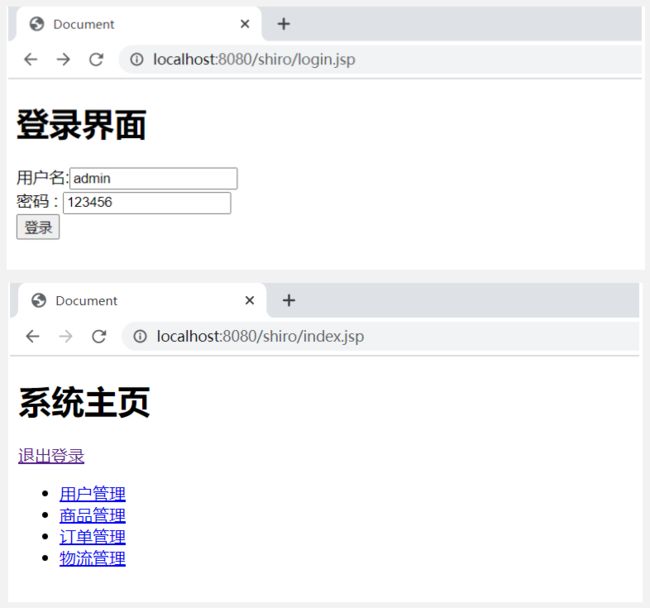
6.8 授权实现
6.8.1 没有数据库
1.页面资源授权
<%@page contentType="text/html;utf-8" pageEncoding="utf-8" isELIgnored="false" %>
<%@taglib prefix="shiro" uri="http://shiro.apache.org/tags" %>
Document
<%-- 受限资源--%>
系统主页
退出登录
2.代码方式授权
@RequestMapping("save")
public String save(){
System.out.println("进入方法");
//基于角色
//获取主体对象
Subject subject = SecurityUtils.getSubject();
//代码方式
if (subject.hasRole("admin")) {
System.out.println("保存订单!");
}else{
System.out.println("无权访问!");
}
//基于权限字符串
//....
return "redirect:/index.jsp";
}
3.方法调用授权
- @RequiresRoles 用来基于角色进行授权
- @RequiresPermissions 用来基于权限进行授权
import org.apache.shiro.authz.annotation.RequiresPermissions;
import org.apache.shiro.authz.annotation.RequiresRoles;
import org.springframework.stereotype.Controller;
import org.springframework.web.bind.annotation.RequestMapping;
@Controller
@RequestMapping("order")
public class OrderController {
@RequiresRoles(value={"admin","user"})//用来判断角色 同时具有 admin user
@RequiresPermissions("user:update:01") //用来判断权限字符串
@RequestMapping("save")
public String save(){
System.out.println("进入方法");
return "redirect:/index.jsp";
}
}
6.8.2 连接数据库
4.授权数据持久化
SET NAMES utf8mb4;
SET FOREIGN_KEY_CHECKS = 0;
-- ----------------------------
-- Table structure for t_perms
-- ----------------------------
DROP TABLE IF EXISTS `t_perms`;
CREATE TABLE `t_pers` (
`id` int(6) NOT NULL AUTO_INCREMENT,
`name` varchar(80) DEFAULT NULL,
`url` varchar(255) DEFAULT NULL,
PRIMARY KEY (`id`)
) ENGINE=InnoDB DEFAULT CHARSET=utf8;
-- ----------------------------
-- Table structure for t_role
-- ----------------------------
DROP TABLE IF EXISTS `t_role`;
CREATE TABLE `t_role` (
`id` int(6) NOT NULL AUTO_INCREMENT,
`name` varchar(60) DEFAULT NULL,
PRIMARY KEY (`id`)
) ENGINE=InnoDB DEFAULT CHARSET=utf8;
-- ----------------------------
-- Table structure for t_role_perms
-- ----------------------------
DROP TABLE IF EXISTS `t_role_perms`;
CREATE TABLE `t_role_perms` (
`id` int(6) NOT NULL,
`roleid` int(6) DEFAULT NULL,
`permsid` int(6) DEFAULT NULL,
PRIMARY KEY (`id`)
) ENGINE=InnoDB DEFAULT CHARSET=utf8;
-- ----------------------------
-- Table structure for t_user
-- ----------------------------
DROP TABLE IF EXISTS `t_user`;
CREATE TABLE `t_user` (
`id` int(6) NOT NULL AUTO_INCREMENT,
`username` varchar(40) DEFAULT NULL,
`password` varchar(40) DEFAULT NULL,
`salt` varchar(255) DEFAULT NULL,
PRIMARY KEY (`id`)
) ENGINE=InnoDB AUTO_INCREMENT=2 DEFAULT CHARSET=utf8;
-- ----------------------------
-- Table structure for t_user_role
-- ----------------------------
DROP TABLE IF EXISTS `t_user_role`;
CREATE TABLE `t_user_role` (
`id` int(6) NOT NULL,
`userid` int(6) DEFAULT NULL,
`roleid` int(6) DEFAULT NULL,
PRIMARY KEY (`id`)
) ENGINE=InnoDB DEFAULT CHARSET=utf8;
SET FOREIGN_KEY_CHECKS = 1;
5.创建实体类
User
@Data
@Accessors(chain = true)
@AllArgsConstructor
@NoArgsConstructor
public class User implements Serializable {
private String id;
private String username;
private String password;
private String salt;
//定义角色集合
private List<Role> roles;
}
Role
@Data
@Accessors(chain = true)
@AllArgsConstructor
@NoArgsConstructor
public class Role implements Serializable {
private String id;
private String name;
//定义权限的集合
private List<Perms> perms;
}
Perms
@Data
@Accessors(chain = true)
@AllArgsConstructor
@NoArgsConstructor
public class Perms implements Serializable {
private String id;
private String name;
private String url;
}
6.创建dao方法
//根据用户名查询所有角色
User findRolesByUserName(String username);
//根据角色id查询权限集合
List<Perms> findPermsByRoleId(String id);
7.mapper实现
<resultMap id="userMap" type="User">
<id column="uid" property="id"/>
<result column="username" property="username"/>
<collection property="roles" javaType="list" ofType="Role">
<id column="id" property="id"/>
<result column="rname" property="name"/>
collection>
resultMap>
<select id="findRolesByUserName" parameterType="String" resultMap="userMap">
SELECT u.id uid,u.username,r.id,r.NAME rname
FROM t_user u
LEFT JOIN t_user_role ur
ON u.id=ur.userid
LEFT JOIN t_role r
ON ur.roleid=r.id
WHERE u.username=#{username}
select>
<select id="findPermsByRoleId" parameterType="String" resultType="Perms">
SELECT p.id,p.NAME,p.url,r.NAME
FROM t_role r
LEFT JOIN t_role_perms rp
ON r.id=rp.roleid
LEFT JOIN t_perms p ON rp.permsid=p.id
WHERE r.id=#{id}
select>
8.Service接口
//根据用户名查询所有角色
User findRolesByUserName(String username);
//根据角色id查询权限集合
List<Perms> findPermsByRoleId(String id);
9.Service实现
@Override
public List<Perms> findPermsByRoleId(String id) {
return userDAO.findPermsByRoleId(id);
}
@Override
public User findRolesByUserName(String username) {
return userDAO.findRolesByUserName(username);
}
10.修改自定义realm
**注意:**如果你创建了一个用户,并为这个用户授予了一个角色,但这个角色并未关联任何的 授权字符串,那么调用数据库获得的结果是 List
package com.lut.shiro.realms;
import com.lut.entity.Perms;
import com.lut.entity.User;
import com.lut.service.UserService;
import com.lut.utils.ApplicationContextUtils;
import org.apache.shiro.authc.AuthenticationException;
import org.apache.shiro.authc.AuthenticationInfo;
import org.apache.shiro.authc.AuthenticationToken;
import org.apache.shiro.authc.SimpleAuthenticationInfo;
import org.apache.shiro.authz.AuthorizationInfo;
import org.apache.shiro.authz.SimpleAuthorizationInfo;
import org.apache.shiro.realm.AuthorizingRealm;
import org.apache.shiro.subject.PrincipalCollection;
import org.apache.shiro.util.ByteSource;
import org.springframework.util.CollectionUtils;
import org.springframework.util.ObjectUtils;
import java.util.List;
//自定义realm
public class CustomerRealm extends AuthorizingRealm {
@Override
protected AuthorizationInfo doGetAuthorizationInfo(PrincipalCollection principals) {
//获取身份信息
String primaryPrincipal = (String) principals.getPrimaryPrincipal();
System.out.println("调用授权验证: "+primaryPrincipal);
//根据主身份信息获取角色 和 权限信息
UserService userService = (UserService) ApplicationContextUtils.getBean("userService");
User user = userService.findRolesByUserName(primaryPrincipal);
System.out.println("user:"+user);
//授权角色信息
if(!CollectionUtils.isEmpty(user.getRoles())){
SimpleAuthorizationInfo simpleAuthorizationInfo = new SimpleAuthorizationInfo();
user.getRoles().forEach(role->{
simpleAuthorizationInfo.addRole(role.getName()); //添加角色信息
//权限信息
List<Perms> perms = userService.findPermsByRoleId(role.getId());
System.out.println("perms:"+perms);
if(!CollectionUtils.isEmpty(perms) && perms.get(0)!=null ){
perms.forEach(perm->{
simpleAuthorizationInfo.addStringPermission(perm.getName());
});
}
});
return simpleAuthorizationInfo;
}
return null;
}
@Override
protected AuthenticationInfo doGetAuthenticationInfo(AuthenticationToken token) throws AuthenticationException {
//根据身份信息//从传过来的token获取到的用户名
String principal = (String) token.getPrincipal();
//在工厂中获取service对象
UserService userService = (UserService) ApplicationContextUtils.getBean("userService");
//根据身份信息查询
User user = userService.findByUserName(principal);
System.out.println("User:"+user);
//用户不为空
if(!ObjectUtils.isEmpty(user)){
//返回数据库信息
SimpleAuthenticationInfo simpleAuthenticationInfo = new SimpleAuthenticationInfo(user.getUsername(), user.getPassword(),
ByteSource.Util.bytes(user.getSalt()), this.getName());
return simpleAuthenticationInfo;
}
return null;
}
}
11.向数据库添加信息
简单来说:
用户 admin 具有 admin的角色,具有 对于 user,order的所有权限
用户 zhangsan 具有 user的角色,没有权限,只能访问公共资源
用户 usermanager 具有 user_manager的角色,具有 对于 user的所有权限
用户 ordermanager 具有 order_manager的角色,具有 对于 order的所有权限
用户 addinfomanager 具有 addinfo_manager的角色,具有 对于 user,order 的添加权限
12.启动测试
6.9 使用CacheManager
6.9.1 Cache 作用
- Cache 缓存: 计算机内存中一段数据
- 作用: 用来减轻DB的访问压力,从而提高系统的查询效率
- 流程:
6.9.2 使用shiro中默认EhCache实现缓存
1.引入依赖
<dependency>
<groupId>org.apache.shirogroupId>
<artifactId>shiro-ehcacheartifactId>
<version>1.5.3version>
dependency>
2.开启缓存
//3.创建自定义realm
@Bean
public Realm getRealm(){
CustomerRealm customerRealm = new CustomerRealm();
//修改凭证校验匹配器
HashedCredentialsMatcher credentialsMatcher = new HashedCredentialsMatcher();
//设置加密算法为md5
credentialsMatcher.setHashAlgorithmName("MD5");
//设置散列次数
credentialsMatcher.setHashIterations(1024);
customerRealm.setCredentialsMatcher(credentialsMatcher);
//开启缓存管理器
customerRealm.setCachingEnabled(true);
customerRealm.setAuthorizationCachingEnabled(true);
customerRealm.setAuthorizationCachingEnabled(true);
customerRealm.setCacheManager(new EhCacheManager());
return customerRealm;
}
3.启动刷新页面进行测试
- 注意:如果控制台没有任何sql展示说明缓存已经开启
6.9.3 shiro中使用Redis作为缓存实现
1.引入redis依赖
<dependency>
<groupId>org.springframework.bootgroupId>
<artifactId>spring-boot-starter-data-redisartifactId>
dependency>
2.配置redis连接
spring.redis.port=6379
spring.redis.host=localhost
spring.redis.database=0
3.启动redis服务
4.开发RedisCacheManager
自定义shiro缓存管理器
package com.lut.shiro.cache;
import org.apache.shiro.cache.Cache;
import org.apache.shiro.cache.CacheException;
import org.apache.shiro.cache.CacheManager;
//自定义shiro缓存管理器
public class RedisCacheManager implements CacheManager {
//参数1:认证或者是授权缓存的统一名称
@Override
public <K, V> Cache<K, V> getCache(String cacheName) throws CacheException {
System.out.println(cacheName);
return new RedisCache<K,V>(cacheName);
}
}
5.开RedisCache实现
自定义redis缓存的实现
package com.lut.shiro.cache;
import com.lut.utils.ApplicationContextUtils;
import org.apache.shiro.cache.Cache;
import org.apache.shiro.cache.CacheException;
import org.springframework.data.redis.core.RedisTemplate;
import org.springframework.data.redis.serializer.StringRedisSerializer;
import java.util.Collection;
import java.util.Set;
//自定义redis缓存的实现
public class RedisCache<k,v> implements Cache<k,v> {
private String cacheName;
public RedisCache() {
}
public RedisCache(String cacheName) {
this.cacheName = cacheName;
}
@Override
public v get(k k) throws CacheException {
System.out.println("get key:"+k);
return (v) getRedisTemplate().opsForHash().get(this.cacheName,k.toString());
}
@Override
public v put(k k, v v) throws CacheException {
System.out.println("put key: "+k);
System.out.println("put value:"+v);
getRedisTemplate().opsForHash().put(this.cacheName,k.toString(),v);
return null;
}
@Override
public v remove(k k) throws CacheException {
System.out.println("=============remove=============");
return (v) getRedisTemplate().opsForHash().delete(this.cacheName,k.toString());
}
@Override
public void clear() throws CacheException {
System.out.println("=============clear==============");
getRedisTemplate().delete(this.cacheName);
}
@Override
public int size() {
return getRedisTemplate().opsForHash().size(this.cacheName).intValue();
}
@Override
public Set<k> keys() {
return getRedisTemplate().opsForHash().keys(this.cacheName);
}
@Override
public Collection<v> values() {
return getRedisTemplate().opsForHash().values(this.cacheName);
}
private RedisTemplate getRedisTemplate(){
RedisTemplate redisTemplate = (RedisTemplate) ApplicationContextUtils.getBean("redisTemplate");
redisTemplate.setKeySerializer(new StringRedisSerializer());
redisTemplate.setHashKeySerializer(new StringRedisSerializer());
return redisTemplate;
}
}
6.启动项目测试发现报错
-
错误解释: 由于shiro中提供的simpleByteSource实现没有实现序列化,所有在认证时出现错误信息
-
解决方案: 需要自动salt实现序列化
- 实现 实体类 序列化
-
自定义salt实现 实现序列化接口
package com.lut.shiro.salt; import org.apache.shiro.codec.Base64; import org.apache.shiro.codec.CodecSupport; import org.apache.shiro.codec.Hex; import org.apache.shiro.util.ByteSource;
import java.io.File;
import java.io.InputStream;
import java.io.Serializable;
import java.util.Arrays;//自定义salt实现 实现序列化接口
public class MyByteSource implements ByteSource, Serializable {private byte[] bytes; private String cachedHex; private String cachedBase64; public MyByteSource(){ } public MyByteSource(byte[] bytes) { this.bytes = bytes; } public MyByteSource(char[] chars) { this.bytes = CodecSupport.toBytes(chars); } public MyByteSource(String string) { this.bytes = CodecSupport.toBytes(string); } public MyByteSource(ByteSource source) { this.bytes = source.getBytes(); } public MyByteSource(File file) { this.bytes = (new com.lut.shiro.salt.MyByteSource.BytesHelper()).getBytes(file); } public MyByteSource(InputStream stream) { this.bytes = (new com.lut.shiro.salt.MyByteSource.BytesHelper()).getBytes(stream); } public static boolean isCompatible(Object o) { return o instanceof byte[] || o instanceof char[] || o instanceof String || o instanceof ByteSource || o instanceof File || o instanceof InputStream; } public byte[] getBytes() { return this.bytes; } public boolean isEmpty() { return this.bytes == null || this.bytes.length == 0; } public String toHex() { if (this.cachedHex == null) { this.cachedHex = Hex.encodeToString(this.getBytes()); } return this.cachedHex; } public String toBase64() { if (this.cachedBase64 == null) { this.cachedBase64 = Base64.encodeToString(this.getBytes()); } return this.cachedBase64; } public String toString() { return this.toBase64(); } public int hashCode() { return this.bytes != null && this.bytes.length != 0 ? Arrays.hashCode(this.bytes) : 0; } public boolean equals(Object o) { if (o == this) { return true; } else if (o instanceof ByteSource) { ByteSource bs = (ByteSource)o; return Arrays.equals(this.getBytes(), bs.getBytes()); } else { return false; } } private static final class BytesHelper extends CodecSupport { private BytesHelper() { } public byte[] getBytes(File file) { return this.toBytes(file); } public byte[] getBytes(InputStream stream) { return this.toBytes(stream); } }}
- 在realm中使用自定义salt ```java @Override protected AuthenticationInfo doGetAuthenticationInfo(AuthenticationToken token) throws AuthenticationException { System.out.println("=========================="); //根据身份信息 String principal = (String) token.getPrincipal(); //在工厂中获取service对象 UserService userService = (UserService) ApplicationContextUtils.getBean("userService"); User user = userService.findByUserName(principal); if(!ObjectUtils.isEmpty(user)){ return new SimpleAuthenticationInfo(user.getUsername(),user.getPassword(), new MyByteSource(user.getSalt()),this.getName()); } return null; }
7.再次启动测试,发现可以成功放入redis缓存
6.9.4 加入验证码验证
1.验证码工具类
package com.lut.utils;
import javax.imageio.ImageIO;
import java.awt.*;
import java.awt.geom.AffineTransform;
import java.awt.image.BufferedImage;
import java.io.File;
import java.io.FileOutputStream;
import java.io.IOException;
import java.io.OutputStream;
import java.util.Arrays;
import java.util.Random;
/**
*@创建人 cx
*@创建时间 2018/11/27 17:36
*@描述 验证码生成
*/
public class VerifyCodeUtils{
//使用到Algerian字体,系统里没有的话需要安装字体,字体只显示大写,去掉了1,0,i,o几个容易混淆的字符
public static final String VERIFY_CODES = "23456789ABCDEFGHJKLMNPQRSTUVWXYZ";
private static Random random = new Random();
/**
* 使用系统默认字符源生成验证码
* @param verifySize 验证码长度
* @return
*/
public static String generateVerifyCode(int verifySize){
return generateVerifyCode(verifySize, VERIFY_CODES);
}
/**
* 使用指定源生成验证码
* @param verifySize 验证码长度
* @param sources 验证码字符源
* @return
*/
public static String generateVerifyCode(int verifySize, String sources){
if(sources == null || sources.length() == 0){
sources = VERIFY_CODES;
}
int codesLen = sources.length();
Random rand = new Random(System.currentTimeMillis());
StringBuilder verifyCode = new StringBuilder(verifySize);
for(int i = 0; i < verifySize; i++){
verifyCode.append(sources.charAt(rand.nextInt(codesLen-1)));
}
return verifyCode.toString();
}
/**
* 生成随机验证码文件,并返回验证码值
* @param w
* @param h
* @param outputFile
* @param verifySize
* @return
* @throws IOException
*/
public static String outputVerifyImage(int w, int h, File outputFile, int verifySize) throws IOException{
String verifyCode = generateVerifyCode(verifySize);
outputImage(w, h, outputFile, verifyCode);
return verifyCode;
}
/**
* 输出随机验证码图片流,并返回验证码值
* @param w
* @param h
* @param os
* @param verifySize
* @return
* @throws IOException
*/
public static String outputVerifyImage(int w, int h, OutputStream os, int verifySize) throws IOException{
String verifyCode = generateVerifyCode(verifySize);
outputImage(w, h, os, verifyCode);
return verifyCode;
}
/**
* 生成指定验证码图像文件
* @param w
* @param h
* @param outputFile
* @param code
* @throws IOException
*/
public static void outputImage(int w, int h, File outputFile, String code) throws IOException{
if(outputFile == null){
return;
}
File dir = outputFile.getParentFile();
if(!dir.exists()){
dir.mkdirs();
}
try{
outputFile.createNewFile();
FileOutputStream fos = new FileOutputStream(outputFile);
outputImage(w, h, fos, code);
fos.close();
} catch(IOException e){
throw e;
}
}
/**
* 输出指定验证码图片流
* @param w
* @param h
* @param os
* @param code
* @throws IOException
*/
public static void outputImage(int w, int h, OutputStream os, String code) throws IOException{
int verifySize = code.length();
BufferedImage image = new BufferedImage(w, h, BufferedImage.TYPE_INT_RGB);
Random rand = new Random();
Graphics2D g2 = image.createGraphics();
g2.setRenderingHint(RenderingHints.KEY_ANTIALIASING,RenderingHints.VALUE_ANTIALIAS_ON);
Color[] colors = new Color[5];
Color[] colorSpaces = new Color[] { Color.WHITE, Color.CYAN,
Color.GRAY, Color.LIGHT_GRAY, Color.MAGENTA, Color.ORANGE,
Color.PINK, Color.YELLOW };
float[] fractions = new float[colors.length];
for(int i = 0; i < colors.length; i++){
colors[i] = colorSpaces[rand.nextInt(colorSpaces.length)];
fractions[i] = rand.nextFloat();
}
Arrays.sort(fractions);
g2.setColor(Color.GRAY);// 设置边框色
g2.fillRect(0, 0, w, h);
Color c = getRandColor(200, 250);
g2.setColor(c);// 设置背景色
g2.fillRect(0, 2, w, h-4);
//绘制干扰线
Random random = new Random();
g2.setColor(getRandColor(160, 200));// 设置线条的颜色
for (int i = 0; i < 20; i++) {
int x = random.nextInt(w - 1);
int y = random.nextInt(h - 1);
int xl = random.nextInt(6) + 1;
int yl = random.nextInt(12) + 1;
g2.drawLine(x, y, x + xl + 40, y + yl + 20);
}
// 添加噪点
float yawpRate = 0.05f;// 噪声率
int area = (int) (yawpRate * w * h);
for (int i = 0; i < area; i++) {
int x = random.nextInt(w);
int y = random.nextInt(h);
int rgb = getRandomIntColor();
image.setRGB(x, y, rgb);
}
shear(g2, w, h, c);// 使图片扭曲
g2.setColor(getRandColor(100, 160));
int fontSize = h-4;
Font font = new Font("Algerian", Font.ITALIC, fontSize);
g2.setFont(font);
char[] chars = code.toCharArray();
for(int i = 0; i < verifySize; i++){
AffineTransform affine = new AffineTransform();
affine.setToRotation(Math.PI / 4 * rand.nextDouble() * (rand.nextBoolean() ? 1 : -1), (w / verifySize) * i + fontSize/2, h/2);
g2.setTransform(affine);
g2.drawChars(chars, i, 1, ((w-10) / verifySize) * i + 5, h/2 + fontSize/2 - 10);
}
g2.dispose();
ImageIO.write(image, "jpg", os);
}
private static Color getRandColor(int fc, int bc) {
if (fc > 255)
fc = 255;
if (bc > 255)
bc = 255;
int r = fc + random.nextInt(bc - fc);
int g = fc + random.nextInt(bc - fc);
int b = fc + random.nextInt(bc - fc);
return new Color(r, g, b);
}
private static int getRandomIntColor() {
int[] rgb = getRandomRgb();
int color = 0;
for (int c : rgb) {
color = color << 8;
color = color | c;
}
return color;
}
private static int[] getRandomRgb() {
int[] rgb = new int[3];
for (int i = 0; i < 3; i++) {
rgb[i] = random.nextInt(255);
}
return rgb;
}
private static void shear(Graphics g, int w1, int h1, Color color) {
shearX(g, w1, h1, color);
shearY(g, w1, h1, color);
}
private static void shearX(Graphics g, int w1, int h1, Color color) {
int period = random.nextInt(2);
boolean borderGap = true;
int frames = 1;
int phase = random.nextInt(2);
for (int i = 0; i < h1; i++) {
double d = (double) (period >> 1)
* Math.sin((double) i / (double) period
+ (6.2831853071795862D * (double) phase)
/ (double) frames);
g.copyArea(0, i, w1, 1, (int) d, 0);
if (borderGap) {
g.setColor(color);
g.drawLine((int) d, i, 0, i);
g.drawLine((int) d + w1, i, w1, i);
}
}
}
private static void shearY(Graphics g, int w1, int h1, Color color) {
int period = random.nextInt(40) + 10; // 50;
boolean borderGap = true;
int frames = 20;
int phase = 7;
for (int i = 0; i < w1; i++) {
double d = (double) (period >> 1)
* Math.sin((double) i / (double) period
+ (6.2831853071795862D * (double) phase)
/ (double) frames);
g.copyArea(i, 0, 1, h1, 0, (int) d);
if (borderGap) {
g.setColor(color);
g.drawLine(i, (int) d, i, 0);
g.drawLine(i, (int) d + h1, i, h1);
}
}
}
public static void main(String[] args) throws IOException {
//获取验证码
String s = generateVerifyCode(4);
//将验证码放入图片中
outputImage(260,60,new File("/Users/chenyannan/Desktop/安工资料/aa.jpg"),s);
System.out.println(s);
}
}
2.开发页面加入验证码
3.开发控制器
@RequestMapping("getImage")
public void getImage(HttpSession session, HttpServletResponse response) throws IOException {
//生成验证码
String code = VerifyCodeUtils.generateVerifyCode(4);
//验证码放入session
session.setAttribute("code",code);
//验证码存入图片
ServletOutputStream os = response.getOutputStream();
response.setContentType("image/png");
VerifyCodeUtils.outputImage(220,60,os,code);
}
4.放行验证码
map.put("/user/getImage","anon");//验证码
5.修改认证流程
@RequestMapping("login")
public String login(String username, String password,String code,HttpSession session) {
//比较验证码
String codes = (String) session.getAttribute("code");
try {
if (codes.equalsIgnoreCase(code)){
//获取主体对象
Subject subject = SecurityUtils.getSubject();
subject.login(new UsernamePasswordToken(username, password));
return "redirect:/index.jsp";
}else{
throw new RuntimeException("验证码错误!");
}
} catch (UnknownAccountException e) {
e.printStackTrace();
System.out.println("用户名错误!");
} catch (IncorrectCredentialsException e) {
e.printStackTrace();
System.out.println("密码错误!");
}catch (Exception e){
e.printStackTrace();
System.out.println(e.getMessage());
}
return "redirect:/login.jsp";
}
6.修改salt不能序列化的问题
//自定义salt实现 实现序列化接口
public class MyByteSource implements ByteSource,Serializable {
private byte[] bytes;
private String cachedHex;
private String cachedBase64;
//加入无参数构造方法实现序列化和反序列化
public MyByteSource(){
}
public MyByteSource(byte[] bytes) {
this.bytes = bytes;
}
public MyByteSource(char[] chars) {
this.bytes = CodecSupport.toBytes(chars);
}
public MyByteSource(String string) {
this.bytes = CodecSupport.toBytes(string);
}
public MyByteSource(ByteSource source) {
this.bytes = source.getBytes();
}
public MyByteSource(File file) {
this.bytes = (new MyByteSource.BytesHelper()).getBytes(file);
}
public MyByteSource(InputStream stream) {
this.bytes = (new MyByteSource.BytesHelper()).getBytes(stream);
}
public static boolean isCompatible(Object o) {
return o instanceof byte[] || o instanceof char[] || o instanceof String || o instanceof ByteSource || o instanceof File || o instanceof InputStream;
}
public byte[] getBytes() {
return this.bytes;
}
public boolean isEmpty() {
return this.bytes == null || this.bytes.length == 0;
}
public String toHex() {
if (this.cachedHex == null) {
this.cachedHex = Hex.encodeToString(this.getBytes());
}
return this.cachedHex;
}
public String toBase64() {
if (this.cachedBase64 == null) {
this.cachedBase64 = Base64.encodeToString(this.getBytes());
}
return this.cachedBase64;
}
public String toString() {
return this.toBase64();
}
public int hashCode() {
return this.bytes != null && this.bytes.length != 0 ? Arrays.hashCode(this.bytes) : 0;
}
public boolean equals(Object o) {
if (o == this) {
return true;
} else if (o instanceof ByteSource) {
ByteSource bs = (ByteSource)o;
return Arrays.equals(this.getBytes(), bs.getBytes());
} else {
return false;
}
}
private static final class BytesHelper extends CodecSupport {
private BytesHelper() {
}
public byte[] getBytes(File file) {
return this.toBytes(file);
}
public byte[] getBytes(InputStream stream) {
return this.toBytes(stream);
}
}
}
7.启动测试
6.9.5 JSP中Shiro常用标签
此模块参考:https://www.cnblogs.com/fancongcong/p/8093258.html
游客访问
user 标签:用户已经通过认证\记住我 登录后显示响应的内容
欢迎[
authenticated标签:用户身份验证通过,即 Subjec.login 登录成功 不是记住我登录的
用户[
notAuthenticated标签:用户未进行身份验证,即没有调用Subject.login进行登录,包括"记住我"也属于未进行身份验证
未身份验证(包括"记住我")
principal 标签:显示用户身份信息,默认调用
Subjec.getPrincipal()获取,即Primary Principal
用户[
hasAnyRoles标签:如果Subject有任意一个角色(或的关系)将显示body体里的内容
用户[
lacksRole:如果当前 Subjec没有角色将显示body体内的内容
用户[
hashPermission:如果当前Subject有权限将显示body体内容
用户[
lacksPermission:如果当前Subject没有权限将显示body体内容
用户[
